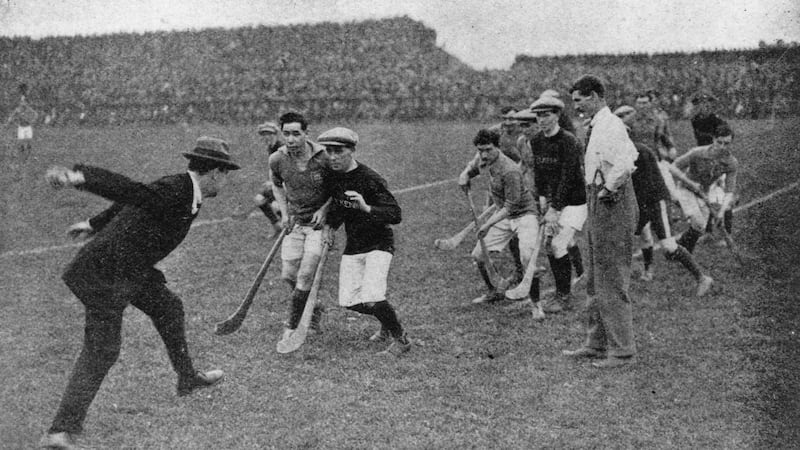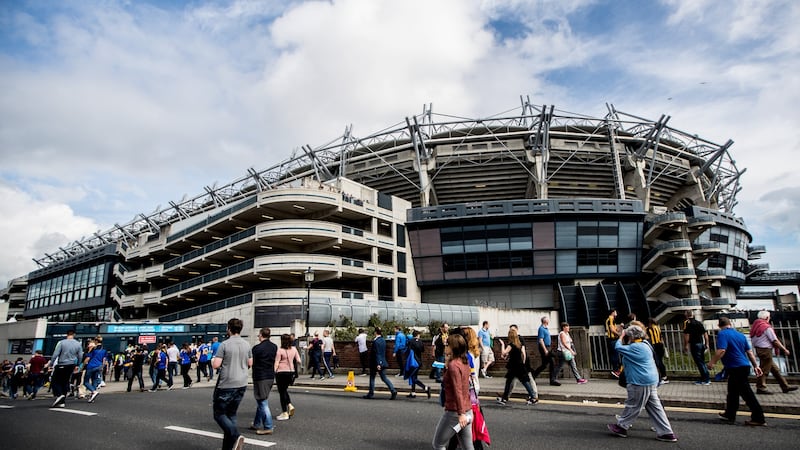In moving belatedly to commemorate Frank Dineen in 2006, the GAA handed him a daunting task. When Croke Park was redeveloped, certain areas of the new stadium were renamed. For instance, the association’s first president Maurice Davin is now associated with the old Canal End in the Davin Stand.
Dineen, who died in 1916, had it harder in being eponymously stitched into Dineen Hill 16, a revised title that however well-meaning was always going to struggle against years of cultural osmosis insisting that it was the “Hill”.
Yet Dineen was one of the most important people in GAA history. His sale in 1913 of what we now know as Croke Park to the association’s Central Council was the culmination of a period of effective trusteeship that kept the venue for Gaelic games.
There’s not much exaggeration in making the argument that this year, 1913, is the most important in the history of Gaelic games. It marked the creation of the two most powerful elements within the association: Croke Park and the games themselves, which shifted into their modern configuration of 15-a-side.
Croke Park in its modern manifestation is both an imposing monument to the GAA as well as formidable engine of revenue, making €118 million for Central Council in the last 14 years.
The venue on Jones’s Road, the City and Suburban Racecourse, went on the market in 1907. Although it was an ideal purchase for the GAA, which had first staged an All-Ireland final there as early as 1896 and leased it regularly, the Association wasn’t in a financial position to acquire it.
Into the picture stepped Frank Dineen, a journalist from Ballylanders in Co Limerick and a GAA activist (he remains the only person to have held the positions of president and general secretary) who bought the ground with his own money and made sundry improvements.

The impetus to buy it back from Dineen came from the desire to commemorate Archbishop Thomas Croke, the first patron of the association.
The means to do so came from a match – paradoxically not an All-Ireland but the 1913 final of the Croke Memorial Cup, a competition that was inaugurated that year to raise funds for a commemorative project.
The reason for the success was the coming together of Louth and Kerry in the football final. The two big rivals of that era hadn’t contested a final for four years. In the 1912 All-Ireland semi-final Kerry had been sensationally beaten by Antrim.
A day after Louth had won the subsequent All-Ireland final the Kerry county board issued a public challenge to the new champions.
The Croke final between the counties didn’t disappoint in any respect. The contest went to a replay and under the new 15-a-side rules – reluctantly accepted by Louth, as the tournament had begun as 17-a-side – the standard of play would live in the memory for a long time and Kerry won the replay decisively, 2-4 to 0-5.
From the GAA’s perspective the crowds attending, estimated at 26,000 and 35,000 for the two matches, both established the games as the pre-eminent attractions in Irish sport and generated sufficient income (£1,183) profit from Kerry-Louth alone) to enable Jones’s Road to be bought for £3,500 and refurbished with the aid of a £2,000 loan from the Munster and Leinster Bank.
Central Council gave the purchase the go-ahead on October 4th, 1913 and after negotiations, news that the deal had been concluded was broken in The Gaelic Athlete at the end of the month and welcomed in the same pages a week later.
The magazine was another product of 1913. Although there had been previous ventures into the business of publishing specialist Gaelic games periodicals this was the first to be published on a weekly basis.

Although not an in-house publication, The Gaelic Athlete was very supportive of the GAA and published by Joe Stanley, proprietor of the Gaelic Press (established 1913), and member of the IRB and Irish Volunteers.
“The purchase of Jones’s Road Grounds by the Central Council,” ran its editorial a week later, “as announced in our issue of last week, has removed what was little short of a reproach upon the GAA. For many years the Gaelic Athletic Association occupied the remarkable position of being the largest users of football and hurling grounds in the country, without the Central body being the possessor of a square yard which it could call its own.”
In a perhaps surprising footnote the decision had been a close-run thing.
Despite Dineen having held onto the Jones’s Road site for the GAA, Central Council nearly opted to build its memorial in Elm Park between Merrion and Clonskeagh on Dublin’s south side. In Tim Carey’s Croke Park: A History, the author points out that the vote in favour of Jones’s Road was only 8-7.
The first final played was the 1913 All-Ireland between Kerry and Wexford on December 14th in the now named Croke Memorial Park.
If the desire for a modern venue reflected a new keenness to enhance the games’ appeal to the public in a rising tide of attendances, so too were other connected factors.
That the games were attracting big crowds in need of better facilities reflected improvement in the quality of the spectacle in football due to advancing training techniques and the decision of Central Council to cut the number of players per team from 17.

Originally teams lined out with 21 players and the rapid reductions in just under 30 years were intended to achieve specific things, according to Professor Paul Rouse of UCD’s School of History, who is a pioneer in the study of sports history.
“The settling on 15 players has to be seen as the latest rule change in a series that brought about an attempt to open up the game, to make it less dangerous to play in and more exciting to watch. It has to be seen in that context.
“Initial scoring allowed a goal to outweigh any number of points. You can dominate a match, score 10 points and still be beaten by a late goal. They change the goal down to five points and then to three. Aside from that injustice you could also see teams score a goal and shut up shop. Puke football has its origins in the 19th century!”
One major rationale for the reduction was the reduction of foul play by making the pitch less congested. This wasn’t welcomed by everyone.
“It seems to me an amazing thing that the motion should have been passed upon such an argument,” wrote Seaghan Ó hÉigeartaigh from Cork to the Gaelic Athlete, “giving as it does the idea of 34 players thirsting to foul one another, while the removal of 4 is going to make fouling a thing of the past.”
Professor Rouse says the reduction was indeed part of a campaign to clean up the games as well.
“Originally the tackle allowed wrestling but slowly the rules attempt to clean up the game. Add to that the ‘tools’ – the equipment and pitches: the quality of hurleys and sliotars was improving; footballs were better; pitches were being cut more regularly and markings were clearer.
“All this was part of a modernisation process that runs parallel to other sports, rugby, soccer, American football and Australian rules. More enjoyable to play and more of a spectacle.”
That trend towards less crowded arenas continued and a year later, Kerry captain Dick Fitzgerald in the GAA’s first coaching manual, ‘How To Play Gaelic Football’ wrote:
“Finally there are some things to be said in favour of the 13-a-side game.”
In what followed he instanced the difficulty for some clubs to find 15 players and the small scale of pitches around the country. He also included arguments of style.
“Again, a certain amount of ground football is an attractive feature in the eyes of the people and the smaller number of players would undoubtedly be forced to develop that side of the game.”
Despite such high-end advocacy, the numbers on teams have stayed constant for more than a century. Since then Croke Park is on its third Hogan Stand and second Cusack Stand.
It now waits silently to resume its historic function in what must be the strangest of times since the remarkable year it was acquired.





















